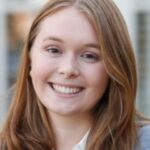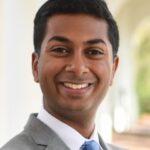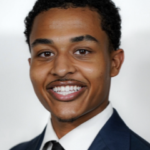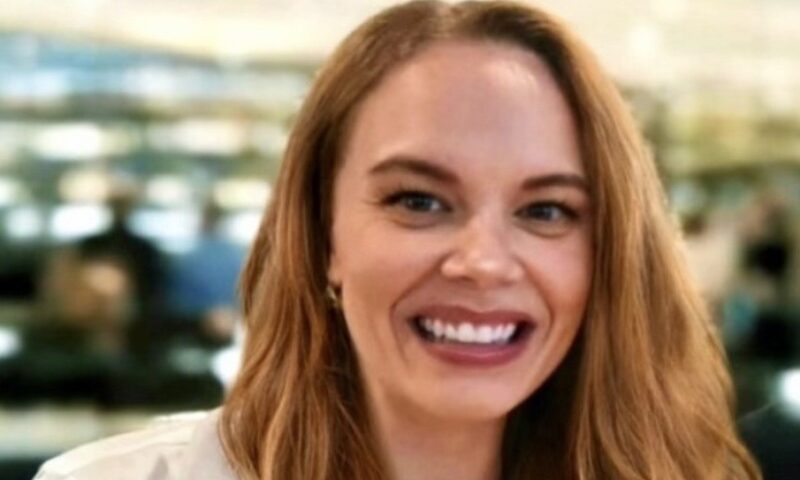Editor’s note: This Investors’ Report story, first published April 21, 2025, illustrates the profound impact of donor contributions and the meaningful difference they make in supporting the McIntire community and advancing our mission to deliver an exceptional business education to our students.
Navigating from learning in the classroom to working on Wall Street can be a daunting process for even the most gifted students. Yet participants of the Finance Academy, an extracurricular program offered by the McIntire School to UVA second-years interested in working in the industry, are well prepared for the many unknowns that come with securing summer internships and full-time positions after graduation.
Since Finance Academy’s inception by Commerce Professors Michael Gallmeyer and David C. Smith in the fall of 2022, over 300 second-year students have completed the program’s seven classroom sessions and had access to third-party valuation instruction as part of the Academy’s December Finance Bootcamp. The Academy culminates in the New York City trek that takes place in January and has become a unique experience for students, offering firsthand insights into the industry and providing unprecedented networking opportunities.
Led by Professors Gallmeyer, Smith, and Brian Healy, with Associate Dean of Career Services Tom Fitch and Assistant Director of Career Development Katie Maher, the trek further extends the Finance Academy’s educational reach, helping to achieve the program’s aim of democratizing financial knowledge.

Charlie Gehringer
“Finance Academy levels the playing field by providing a curriculum that caters specifically to the process we’re involved in,” Charlie Gehringer (McIntire ’27) says, crediting the commitment of the readily accessible faculty who are integral to the students’ success in the program.
The comprehensive nature of the Finance Academy equips students with essential financial skills and knowledge through a practical, targeted approach—one that leads to the hands-on experience in the Big Apple.
A Full Finance Schedule
The trek’s packed itinerary creates a steady sequence of hands-on learning and networking opportunities for Finance Academy participants. Students are immersed in the industry, bridging their on-Grounds education with real-world exposure to more than a dozen firms in banking, private equity, wealth management, sales and trading, and in the most recent edition, a debt fund. As attendance at all visits is required, students spend 90 minutes to two hours at each of the multiple organizations over the course of four days—in addition to any separate coffee chats and other one-on-one meetings that many students schedule themselves.
Healy notes the banks attempt to differentiate from one another by incorporating case studies about deals the firms have been involved in and other pertinent activities that dive much deeper than mere info sessions, with each organization attempting to become more memorable to the student attendees who may one day start their careers there. With each visit managed by a high number of UVA alumni employed at the firms, students meet with many representatives who were somewhat recently students themselves and therefore understand the intricacies of the recruitment process as well as the importance of connections, which can be pivotal in procuring any position.
Indeed, the networking interactions and access to finance professionals that are afforded to students on the trek cannot be understated. Healy says that the preliminary results relating to students receiving job offers have been overwhelmingly positive and highlight an essential service as the job market becomes ever more competitive for new talent.
“Getting students to New York and in front of all the banks during the trek imparts a higher level of seriousness when they later interview with these firms,” says Healy. “Students can say that they met with specific people at the company, showing an already established familiarity, which is another important part of this networking process.”
Building Relationships Onsite
The trek often provides the first real-life glimpse into what it’s like to be employed at these firms. Students were unanimous in how eye-opening it was to be onsite.

Ethan Schwimmer
“You don’t really get a sense of the energy of a bank or a workplace until you’ve actually been there and seen how all these people interact with each other,” says Ethan Schwimmer (A&S ’25, McIntire ’25). “The way they talked amongst themselves when they were giving the presentations, the way they carried themselves afterwards as we were networking made it all feel a lot more real to me,” says the Los Angeles native who is returning to Southern California after graduation to work in Houlihan Lokey’s LA-based restructuring group.

James Cooney
James Cooney (McIntire ’26) had a similar reaction: “Just being in the office and hearing from actual industry professionals about what they do on a day-to-day basis make the entire experience much more tangible,” says Cooney, who will work as an Investment Banking Summer Analyst at J.P. Morgan. “It not only added a bit more motivation for something to work towards, it better contextualizes everything for a more holistic picture of the industry.”
Gehringer, who will serve as an Investment Analyst this summer for Charlottesville-based firm Investure and will be accepting a position with Guggenheim after he graduates next year, says the visits made his future goals more realistic because it was suddenly easier to visualize: “Visiting the banks gave me an appreciation for the culture and enthusiasm of each firm. You think about the office and the people you talk to when you’re finally making your decision. Having more face-to-face contact with the bankers themselves, you can better see yourself in that situation.”

Shruta Thum
Shruta Thum (McIntire ’27) took the opportunity of being in New York to network further than what was scheduled during the official bank visits, reaching out to a contact she had made at Morgan Stanley. “I met with somebody I had been talking to for a long time because I knew that I was going to be in town,” she shares. “It was a really cool experience because it felt less structured and planned than the visits but was still a great way to learn about the firm and the culture at the bank,” she says, adding that in the summer of 2026, she’ll intern with Goldman Sachs in New York.
“It showed me how invested the professionals are in our success, with the only tie really being that we’re from the same school,” says Thum. “They really do care about helping everybody at UVA to not just land a job at their firm but land the best possible job that they can have.”

Ellie Ferrell
The NYC trek allowed Ellie Ferrell (McIntire ’25), who will be joining Barclays in New York as an Investment Banking Analyst, to forge professional relationships and to reintroduce herself to people at her future employer whom she had met previously. “It offered a natural connection to professionals that was solidified by going up to New York. Every bank gave us a list of people to reach out to, so being on the trek was helpful because I didn’t feel like I was cold emailing people as much as I could say, ‘We met in New York,’ or ‘I listened to your presentation.’ It was really helpful in getting people to respond or call their attention to emails, and it gave me a solid footing before going into the recruiting cycle, which can be really overwhelming since you are only a second-year when you do it,” Ferrell insists.
Valuable Lessons and Relationships
Though most are interested in securing a position in banking, not all students who go on the trek decide to pursue that path.

Emily Vajda
Before the trek, History major Emily Vajda (A&S ’25) had already secured an internship with PwC’s risk consulting practice in New York, where she will return after graduation. Yet what she learned on the visits and in the Finance Academy program continued to be worthwhile: “It gave me a great education going into my internship,” she says. “In talking to my superiors, I understood details about the finance world at large that a lot of interns from other schools I was in the pod with did not—especially when it came to understanding market risk, interest rates, and currency exchange rates.”

Saahas Gowda
Saahas Gowda (McIntire ’26), who is headed to Boston this summer to intern as an Associate Consultant at Bain & Company, says that though he was drawn to a career in consulting when he first came to UVA, the earlier recruitment cycle of banking appealed to him. Despite the fact that he was unable to land an offer, Gowda pivoted, returning to his initial desire to pursue consulting. Still, the trek remained valuable.
“It gave me a better understanding of what investment banking would look like, and as a professional, what my experience would be—a lot of that was still transferable to consulting,” he says. “Going to these firms and seeing these presentations made me realize I enjoyed the valuation side of things. And I will be most likely in the private equity group at Bain this summer, so a lot of what I learned is still applicable. I became more excited about working on deals because of the trek.”

Hamdael Eslaquit
For Hamdael Eslaquit (McIntire ’27), a first-generation college student and Echols Scholar who will serve as an Investment Analyst Intern at UVIMCO this summer before heading to Bank of America in New York for an Investment Banking internship in 2026, the trek reshaped his perspective on what truly mattered in the recruiting process. He joined the program trusting that it would help him better understand the investment banking recruiting process, first hearing about the opportunity from Gowda, as the two were members of the SEED Consulting Group student org. But by the end of the trip, his mindset had shifted: just securing any offer wouldn’t cut it—he sought the best overall fit.
He approached each visit as a chance to evaluate fit holistically, closely observing firm culture through small but telling details: “How we were welcomed, the number of alumni present, how employees interacted, even how offices were laid out. If managing directors were seated above analysts, that suggested a hierarchy. All of that helped me gauge whether a place aligned with my values.”
Additionally, Eslaquit took detailed notes on the deals each bank highlighted for future touchpoints. “The detail and complexity that went into those presentations sparked many questions that came up after the trek but also gave me ammunition to use in interviews. I knew these deals in such depth that when I was doing my banking interviews, I was speaking on points you wouldn’t find in the press,” he recalls. “That also gave me leverage when I was recruiting to make myself stand out as a candidate.”
Eslaquit is quick to credit faculty for making “all the difference,” as they served as resources beforehand and supported him and his classmates throughout the trek; that assistance included having Smith facilitate a personal introduction to a managing director that Eslaquit says allowed him to initiate a meaningful follow-up conversation.
He appreciated the time and attention Smith routinely provided when he was most unsure about his future: “Those were the moments that mattered the most to me because I didn’t feel like I was in it alone. I knew I’d be okay if I didn’t get any offers because I still had this person guiding me through the process. That was the most important takeaway for me.”



